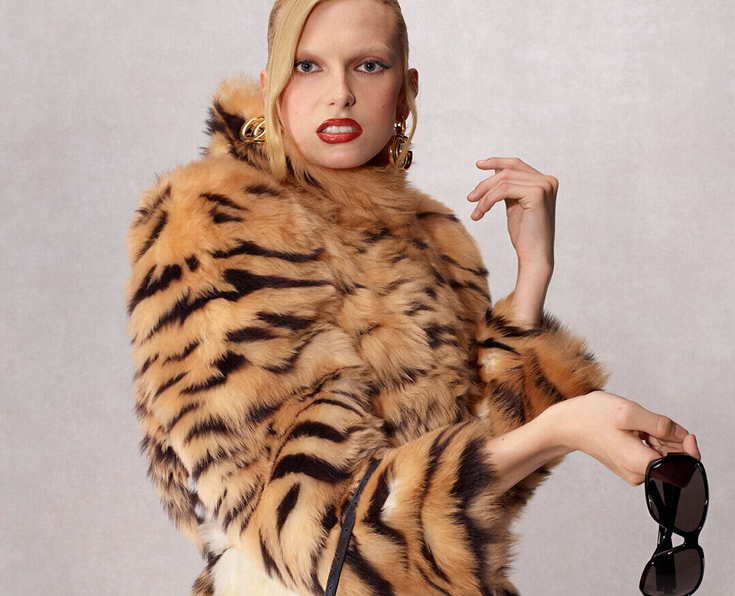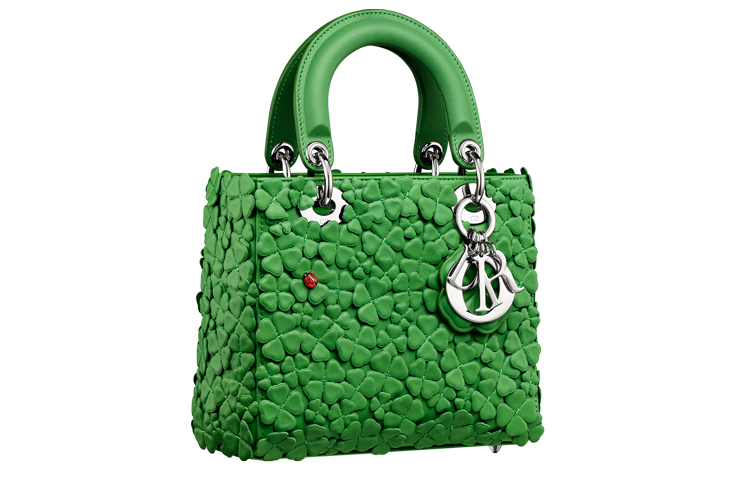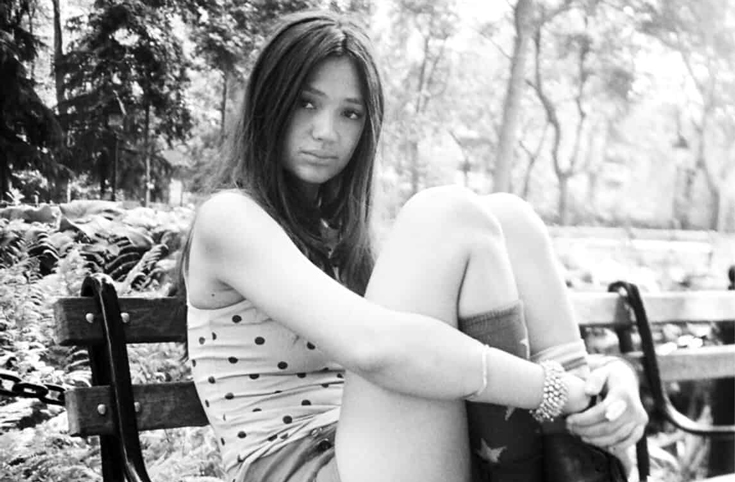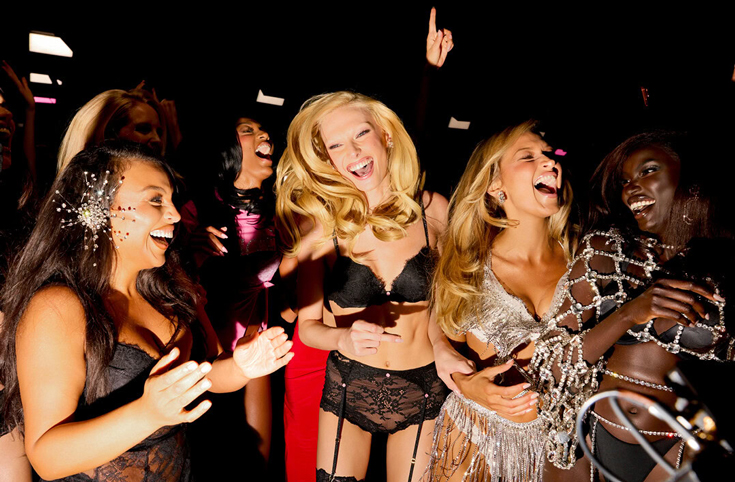ETHEL CAIN: PERFECT STORM

Hayden Silas Anhedönia, better known by her alter ego and stage name Ethel Cain, has spent the last four months in her Pittsburgh home falling asleep to tornado compilation footage on YouTube. She likes how “big and catastrophic, but so peaceful and intimate” a storm can be. A storm on the horizon is the guiding darkness, as Anhedönia writes and produces her next bodyof work: an EP she refers to as B-sides that explores thecharacter of Cain’s late teenage years. It’s the final chapter for the young character of Ethel Cain – even though she is already dead. Let us explain.
Welcome to the mystical, mesmerising, morbid world of Ethel Cain. The character that 25-year-old Anhedönia dreamt up in 2018 has had a wild ride. She rose – and fell – on Anhedönia’s 2022 debut album Preacher’s Daughter. The concept album that chronologically followed Cain’s life saw her escape a religious upbringing, tumble into an ill-fated romance and spiral into a world of kidnapping, prostitution and drug addiction before being killed by her lover – by way of cannibalisation, no less. The story acts as a wicked love letter to the South, where Anhedönia grew up in a Southern Baptist family in Perry, Florida, attending church a few times a week. She left the church at age 16 after coming out as gay, left home at 18 and then came out as a transgender woman at 20. Her youth and adolescence informed the fictional story of Cain, an unattainable American Dream, and Preacher’s Daughter became a “cautionary tale” of the dangers of not freeing yourself from the weight of religion and other people’s expectations.
From the album’s anthem American Teenager to the emotionally jarring (and honestly, quite terrifying) Ptolemoea, Anhedönia set out to create an American cinematic epic. She achieved it, unearthing a cult following of fans who refer to themselves as “daughters” to her “Mother Cain”. It has resonated deeply with a global fanbase that attend her shows in Cain-inspired looks: prairie dresses, cross necklaces, bare-faced. “I always consider Preacher’s Daughter not to be an album, but a soundtrack,” she says. “Every song is tonally different to represent a part of the story. I think concept albums always do really well for the same reason that films and books are very popular. When it’s a concept album, not only is there music, but there’s a character to hold onto, there’s a storyline to follow.” That storyline is being further explored as Anhedönia works on the B-Sides, going back in time to Cain’s adolescence to wrap up the story. After this EP, the character of Cain “will be done”, says Anhedönia. “I won’t be speaking from her point of view anymore.” The trilogy will continue, however, by exploring Cain’s mother and grandmother. “The sonic language will change, everything will be new. This is the final send-off for Ethel, the granddaughter.” It’s an emotional, bittersweet experience she’s been leaning into. “It feels good to feel bad sometimes. I love to make a project that’s a little bit melodramatic if you will – or a lot melodramatic, as is often the case… I was very scared to put out Preacher’s Daughter because I had no idea how people would react. Now that I know that they’re [okay] with it and receptive to the idea, the concept, the format, I can relax and create more openly.”
Inspired by Christian singers Nichole Nordeman, who she cites as “extremely influential to my sound”, and Australian Michelle Tumes’s emotionally charged, soft, heavenly songs, Anhedönia began learning and playing instruments in her bedroom as a teenager. With no creative community and no means to record or release anything, those experiments never left her bedroom. Anhedönia started putting music online as an adult when her best friend encouraged her to “properly make a song”. She began recording vocals on her headphone microphone into GarageBand, layering them with synths to create a collection of songs that sounded like “very weird, churchy but electronic hymns”. High on the rush that making music gave her, she did it again and again, releasing everything she made online. “It was actually less intimidating back then because nobody was listening. There was no audience. I was putting it into a void of the internet almost. I would put the demos out on Soundcloud and Tumblr. I was still doing it up until Preacher’s Daughter came out. Then when that was out there, way more people were listening so it became a lot harder to scrub it off the internet.” The evolution of her music-making has resulted in the signature sound of Cain: addictively dark and devastating, but provocative, liberating (her most famous lyric stamped on both her social media and her body – her fans’ too – is “God loves you, but not enough to save you”) and filled with memorable hooks. Anhedönia writes and produces the majority of her music herself. Influenced by a slew of brilliant artists including Florence Welch, Elena Tonra of Daughter, ImogenHeap, Jillian Banks and Susanne Sundfør, she sits at the “weird intersection” between indie-folk, acoustic folk, electronic and experimental pop with dark depths and ethereal highs.
Creating the visual world of Ethel Cain came naturally. Heavily influenced by the Southern gothic genre, Anhedönia says, “I have a core inspiration that never goes away, which is old photographs, old stories that my grandparents have told me, and the old media that I’ve grown up on. The ’60s to the ’80s, that era of television and film, the books I grew up reading. That will always be the core inspiration for the Ethel Cain project.” Recently, she’s been allowing herself to create more freely. She’s open to new ideas, evolutions and accepting deviations from her clearly outlined plan for the persona. The character of Cain’s style is also evolving. It began at now-defunct label Gunne Sax: think Little House on the Prairie meets Picnic at Hanging Rock. “Personal style has always been very funny because growing up, you know, Christian household, we didn’t really have freedom of style of our clothes. When I started Ethel it kind of tapped back into that love I have of these older styles of clothing – the white dresses, the prairie dresses I associated with the toiling lifestyle of being that kind of rural motherly figure I always admired, like Caroline Ingalls [whose daughter Laura wrote Little House]. [They] never looked fancy, but every so often would put on their Sunday best, which was this beautiful, white or pastel blue they would wear to church. It very much resonated with me, as this Sunday best ideal. I always loved the Gunne Sax dresses. That’s where Ethel Cain got her fashionable start in the beginning when she was more of a caricature and I didn’t have the full story of the trilogy. She was just in white dresses, with long brown hair, very pretty. As the character started to diversify and split into three, that went away because it’s not so much her. That would be more of her mother or grandmother. She’s a very spunky teenager in her overalls, jeans and cutoff T-shirts. She’s a little country ragamuffin, so that’s been more of my style recently.”
Anhedönia herself has had a major fashion moment. She walked in the Miu Miu AW23 show, featuring expertly dishevelled models in prim and proper cardigans paired with panties, messy hair and sling-back kitten heels. “That was fun because it was a foray into fashion that mirrored what I like to wear. It was a cool collection to walk. I remember telling the stylist, ‘I feel like I have this at home in my closet’, which never happens when you’re about to walk a runway. At least not for me. It was very ’70s, very secretary. I really liked it.” Anhedönia slinked around in the collection for our story, before taking to the “beautiful, iconic” Sydney Opera House stage to perform at the Vivid festival, where her “daughters” came to see her in Cain-core looks. Anhedönia’s audience are ride-or-die, fuelled by the freedom felt in her music and lyrics, and inspired by her meticulous storytelling. Her ability to craft the world of Cain has informed Anhedönia’s own view of the world. “It’s given me a more insightful look [into] how I interact with people in the world around me and how I digest the things around me, the things I hear, see and smell. It’s really allowed me to zoom out. If anything, it’s given me the freedom to honestly do exactly what I want to do and enjoy the things I enjoy. I used to be very worried that the way I was living my life was just a placeholder until I was doing the right thing. Now I feel like whatever I’m doing at that moment is how I’m supposed to be spending that moment. It’s taught me to be patient and content, and accept what’s happening as what was always going to happen. To not feel like I should have been doing something else and to live in the moment. Not spend it looking for other possibilities. That’s what it’s led me to.”
Anhedönia is relishing in the liberation of her meteoric rise, letting her simply be at home, take things slowly, see the world and create at her own pace. “I think that the freedom is the biggest joy that I have found in this career so far. It’s allowed me to be at home, be quiet, be focused in a way I value. It allows me to stop at the quiet moments and be able to take them in instead of being distracted. I’ve cherished the ability to stop and smell the flowers. I’m appreciative that all the hard work I’ve put in has paid off to a place where I can slow down and focus on the little things that matter to me.” Godspeed.
Ethel Cain wears Miu Miu throughout. Taken from 10 Magazine Australia Issue 22.
















